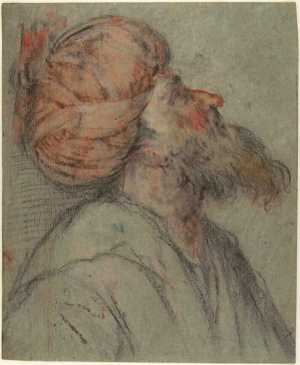Specifications
| Title | Bearded Man Wearing a Turban Looking Up |
|---|---|
| Material and technique | Black and coloured chalks, heightened with white, on discoloured blue paper |
| Object type |
Drawing
> Two-dimensional object
> Art object
|
| Location | This object is in storage |
| Dimensions |
Height 175 mm Width 143 mm |
|---|---|
| Artists |
Draughtsman:
Jacopo Bassano (Jacopo da Ponte)
|
| Accession number | I 516 (PK) |
| Credits | Loan Stichting Museum Boijmans Van Beuningen (former Koenigs collection), 1940 |
| Department | Drawings & Prints |
| Acquisition date | 1940 |
| Creation date | in circa 1550-1560 |
| Watermark | not visible because of backing sheet (vH, ?P) |
| Inscriptions | ‘B.B.no:45’ (verso, above centre, pen and brown ink) |
| Collector | Collector / Franz Koenigs |
| Mark | Z. Sagredo (L.2103a, on backing sheet) inv. B.B. no= 45, F.W. Koenigs (L.1023a, on backing sheet) |
| Provenance | Zaccaria Sagredo (1653-1729, L.2103a, inv. B.B.no:45'), Venice; Marie Marignane Patissou (c. 1880-1925, L.1848), Paris; (?) Art dealer Paul Cassirer, Amsterdam;Franz W. Koenigs (1881-1941, L.1023a), Haarlem, possibly acquired in 1928; D.G. van Beuningen (1877-1955), Rotterdam, acquired with the Koenigs Collection in 1940 and donated to Stichting Museum Boijmans Van Beuningen |
| Exhibitions | Amsterdam 1929, no. 168; Venice/Florence 1985, no. 32; Rotterdam/New York 1990, no. 66; Rotterdam 2009 (coll 2 kw 2); Bassano del Grappa/Fort Worth 1992, no. 110. |
| Internal exhibitions |
Van Pisanello tot Cézanne (1992) De Collectie Twee - wissel II, Prenten & Tekeningen (2009) |
| Research |
Show research Italian Drawings 1400-1600 |
| Literature | Amsterdam 1929, no. 168 (F. Bassano); Tietze/Tietze-Conrat 1944, no. 153; Arslan 1960, vol. 1, p. 176 (J. or F. Bassano); Ballarin 1971, p. 141, fig. 7; Rearick 1980a, p. 373; Aikema/Meijer 1985, no. 32, ill.; Rearick 1987, no. I.3, pl. II-b; Luijten/Meij 1990, no. 66, ill. Bassano del Grappa/Fort Worth 1992, no. 110. ill. |
| Material | |
| Object | |
| Technique |
Highlight
> Painting technique
> Technique
> Material and technique
|
| Geographical origin | Italy > Southern Europe > Europe |
| Place of manufacture | Venice > Veneto region > Italy > Southern Europe > Europe |
Do you have corrections or additional information about this work? Please, send us a message
























